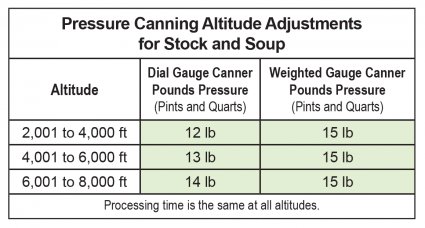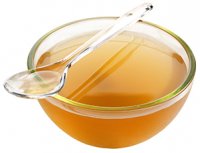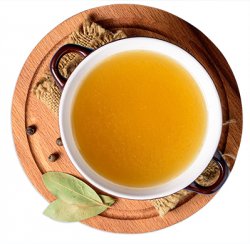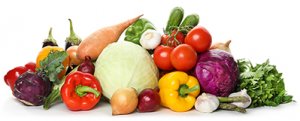Boiling Water Method | Fruits | Tomatoes and Tomato Products | Vegetables | Meat, Game and Poultry
Fish and Seafood | Stock and Soup | Troubleshooting | Care and Maintenance | Pressure Canner Comparison Guide

STOCK AND SOUP CANNING BASICS
Pressure Canning is the ONLY SAFE METHOD for canning stock and soup.
Stock and soup are quickly and easily canned. Generally, vegetable soup is more satisfactory if the stock and vegetables are canned separately and combined at the time of serving.
Adjusting for High Altitude Canning:
- Dial Gauge Pressure Canner: When pressure canning at altitudes of 2,000 feet or below, process according to specific recipe. When canning at higher altitudes, process according to the Pressure Canning Chart below.
- Weighted Gauge Pressure Canner: When pressure canning at altitudes of 1,000 feet or below, process according to specific recipe. When canning at higher altitudes, process according to the Pressure Canning Chart below.
- Presto Precise® Digital Pressure Canner: When pressure canning, this canner automatically adjusts for altitude. There is no adjustment necessary.

PROCEDURES AND RECIPES
BEEF STOCK pints | quarts
 Saw or crack fresh trimmed beef bones to enhance extraction of flavor. Rinse bones.
Saw or crack fresh trimmed beef bones to enhance extraction of flavor. Rinse bones.
Hot Pack: Place bones in a large pot and cover with water. Cover pot and simmer 3 to 4 hours. Remove bones. Cool broth; skim off and discard fat. Remove bits of meat from bones and add to broth, if desired. Reheat broth to boiling. Fill hot jars with hot broth, leaving 1-inch headspace.
Remove air bubbles. Clean jar rims. Position lids on jars and adjust bands fingertip tight.
 Pressure Canning
Pressure Canning
Follow manufacturer’s instructions for pressure canning method and canner-specific jar capacity.
- Dial Gauge Canner. Process at 11 pounds pressure—Pints 20 minutes and Quarts 25 minutes. For processing above 2,000 feet altitude, see chart for recommended pounds pressure.
- Weighted Gauge Canner. Process at 10 pounds pressure—Pints 20 minutes and Quarts 25 minutes. For processing above 1,000 feet altitude, use 15 pounds pressure.
- Presto Precise® Digital Canner. Process Pints 20 minutes and Quarts 25 minutes. Canner automatically adjusts for altitude in pressure canning mode.
CHICKEN STOCK pints | quarts
 Hot Pack: Place large carcass bones in a large pot; add enough water to cover bones. Cover pot and simmer 30 to 45 minutes or until meat can be easily removed from bones. Remove bones. Cool broth; skim off and discard fat. Remove bits of meat from bones and add to broth, if desired. Reheat broth to boiling. Fill hot jars with hot broth, leaving 1-inch headspace.
Hot Pack: Place large carcass bones in a large pot; add enough water to cover bones. Cover pot and simmer 30 to 45 minutes or until meat can be easily removed from bones. Remove bones. Cool broth; skim off and discard fat. Remove bits of meat from bones and add to broth, if desired. Reheat broth to boiling. Fill hot jars with hot broth, leaving 1-inch headspace.
Remove air bubbles. Clean jar rims. Position lids on jars and adjust bands fingertip tight.
 Pressure Canning
Pressure Canning
Follow manufacturer’s instructions for pressure canning method and canner-specific jar capacity.
- Dial Gauge Canner. Process at 11 pounds pressure—Pints 20 minutes and Quarts 25 minutes. For processing above 2,000 feet altitude, see chart for recommended pounds pressure.
- Weighted Gauge Canner. Process at 10 pounds pressure—Pints 20 minutes and Quarts 25 minutes. For processing above 1,000 feet altitude, use 15 pounds pressure.
- Presto Precise® Digital Canner. Process Pints 20 minutes and Quarts 25 minutes. Canner automatically adjusts for altitude in pressure canning mode.
SOUP — Vegetable, Dried Bean or Pea, Meat, Poultry, or Seafood* pints | quarts
 Choose your favorite vegetables, dried beans or peas, meat, poultry, or seafood ingredients for soup as long as those ingredients have their own individual canning recommendations. Do not use ingredients for which there are no canning recommendations.
Choose your favorite vegetables, dried beans or peas, meat, poultry, or seafood ingredients for soup as long as those ingredients have their own individual canning recommendations. Do not use ingredients for which there are no canning recommendations.
CAUTION! In accordance with USDA guidelines, do not add noodles or other pasta, rice, cured or brined meat, flour, cream, milk or other thickening agents to home canned soup as processing time may not be adequate.
Hot Pack: Prepare vegetables, meat, poultry, and seafood* as described in the hot pack directions for the individual ingredients. If dried beans or peas are used, they must be fully rehydrated before adding to other ingredients (see vegetables). Combine solid ingredients with meat broth, tomatoes, or water to cover. Boil 5 minutes. Salt to taste, if desired. Fill hot jars halfway with solid ingredients and then add soup liquid, leaving 1-inch headspace.
Remove air bubbles. Clean jar rims. Position lids on jars and adjust bands fingertip tight.
 Pressure Canning
Pressure Canning
Follow manufacturer’s instructions for pressure canning method and canner-specific jar capacity.
- Dial Gauge Canner. Process at 11 pounds pressure—Pints 60 minutes and Quarts 75 minutes. For processing above 2,000 feet altitude, see chart for recommended pounds pressure.
- Weighted Gauge Canner. Process at 10 pounds pressure—Pints 60 minutes and Quarts 75 minutes. For processing above 1,000 feet altitude, use 15 pounds pressure.
- Presto Precise® Digital Canner. Process Pints 60 minutes and Quarts 75 minutes. Canner automatically adjusts for altitude in pressure canning mode.
*If soup contains seafood, process pints and quarts for 100 minutes.

Boiling Water Method | Fruits | Tomatoes and Tomato Products | Vegetables | Meat, Game and Poultry
Fish and Seafood | Stock and Soup | Troubleshooting | Care and Maintenance | Pressure Canner Comparison Guide
